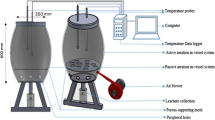Abstract
This study aimed to determine the initial air pressure influence on the in-vessel composting for the biodegradable fraction of municipal solid waste in Morocco. For this purpose, representative composting mixture was prepared in which C/N ratio was 26 and moisture content was 70 %. The in-vessel bioreactor was designed and used specially to evaluate the initial air pressure effect on composting process in this study. Thus, daily changes of internal air pressure and temperature were monitored, and physicochemical properties of different composts obtained were also analyzed and compared. Experimental results showed a significant increase in internal pressure corresponding to the initial air pressure of 0.6 bar and a slight increase for the other initial air pressures. The initial air pressure which equal to 0.6 bar allowed maximum value of temperature and final composting product with good physicochemical properties as well as higher organic matter degradation and higher gas production. Composts obtained from experiments under 0.4 and 0.8 bar showed good maturity levels and may also be used for agricultural applications.




Similar content being viewed by others
References
Ahn HK, Richard TL, Glanville TD (2008) Optimum moisture levels for biodegradation of mortality composting envelope materials. Waste Manag (Oxford) 28:1411–1416
Avnimelech Y, Bruner M, Ezrony I, Sela R, Kochba M (1996) Stability indexes for municipal solid waste compost. Compost Sci Util 4:13–20
Cekmecelioglu D, Demirci A, Graves R, Davitt N (2005) Applicability of optimized in-vessel food waste composting for window system. Biosyst Eng 91:479–486
Chang J, Tsai J, Wu K (2006) Thermophilic composting of food waste. Bioresour Technol 97:116–122
Corti C, Crippa L, Genevini P, Centemero M (1998) Compost use in plant nurseries: hydrological and physicochemical characteristics. Compost Sci Util 6:35–45
Département de l'Environnement (2001) Rapport sur l’état de l’environnement du Maroc. Département de l’Environnement Maroc
Diaz M, Madejon E, Lopez F, Lopez R, Cabrera F (2002) Optimization of the rate vinasse/grape marc for co-composting process. Process Biochem 37:1143–1150
Erhart E, Burian K (1997) Evaluating quality and suppressiveness of Austrian biowaste composts. Compost Sci Util 5:15–24
Eurostat (2009) La production végétale dans les pays partenaires méditerranéens continue d’augmenter
Fogarty A, Tuovinen O (1991) Microbiological degradation of pesticides in yard waste composting. Microbiol Rev 55:225–233
Gao M, Li B, Yu A, Liang F, Yang L, Sun Y (2010) The effect of aeration rate on forced-aeration composting of chicken manure and sawdust. Bioresour Technol 101:1899–1903
Hirai M, Chanyasak V, Kubota H (1983) A standard measurement for compost maturity. Biocycle 24:54–56
Kulcu R, Yaldiz O (2004) Determination of aeration rate and kinetics of composting some agricultural wastes. Bioresour Technol 93:49–57
Larsen KL, McCartney DM (2000) Effect of C:N ratio on microbial activity and n retention in benchscale study using pulp and paper biosolids. Compost Sci Util 8:147–159
Leclerc B (2001) Guide des matières organiques. Guide Technique de l’ITAB
Liang C, Das K, McClendon R (2003) The influence of temperature and moisture contents regimes on the aerobic microbial activity of a biosolids composting blend. Bioresour Technol 86:131–137
Lu Y (2000) Analytical methods on soil agrochemistry. China Agriculture Technology Press, China (in Chinese)
Petrica I, Sestanb A, Sestan I (2009) Influence of initial moisture content on the composting of poultry manure with wheat straw. Biosyst Eng 104:125–134
Richard TL, Hamelers HVM, Veeken A, Silva T (2002) Moisture relationships in composting processes. Compost Sci Util 10:286–302
Riffaldi R, Levi-Minzi R, Pera A, de Bertoldi M (1986) Evaluation of compost maturity by means of chemical and microbial analyses. Waste Manag (Oxford) 4:387–396
Sadaka S, El.Taweel A (2003) Effect of aeration and C/N ratio on household waste composting in Egypt. Compost Sci Util 11:36–40
Sharma M, McBean E (2009) Strategy for use of alternative waste sort sizes for characterizing solid waste composition. Waste Manag Res 27:38–45
Soumaré M, Demeyer A, Tack F (2002) Chemical characteristics of Malian and Belgian solid waste composts. Bioresour Technol 81:97–101
Tiquia S, Tam N (2002) Characterization and composting of poultry litter in forced-aeration piles. Process Biochem 37:869–880
Velan P, Tsai J, Lu L, Lin J (2005) Fast composting of bear manufactures wastes using thermophilic bio reactor. In: Proceedings of international conference on advances industrial waste treatment, pp 319–224, Anna University, Chennai-25, India, ISBN 81-7764-773-3
Wong J, Fang M (2000) Effects of lime addition on sewage sludge composting process. Water Resour 34:3691–3698
Zaman AU (2013) Life cycle assessment of pyrolysis–gasification as an emerging municipal solid waste treatment technology. Int J Environ Sci Technol 10(5):1029–1038
Zucconi F, de Bertoldi M (1987) Compost specifications for the production and characterization of compost from municipal solid waste. In: de Bertoldi M et al (eds) Compost: production, quality and use. Elsevier Applied Science, London, pp 30–50
Acknowledgments
The authors wish to extend their gratitude to all who supported this work.
Author information
Authors and Affiliations
Corresponding author
Rights and permissions
About this article
Cite this article
Makan, A., Assobhei, O. & Mountadar, M. Initial air pressure influence on in-vessel composting for the biodegradable fraction of municipal solid waste in Morocco. Int. J. Environ. Sci. Technol. 11, 53–58 (2014). https://doi.org/10.1007/s13762-013-0434-6
Received:
Revised:
Accepted:
Published:
Issue Date:
DOI: https://doi.org/10.1007/s13762-013-0434-6




